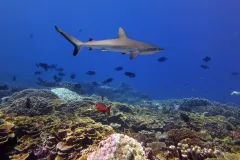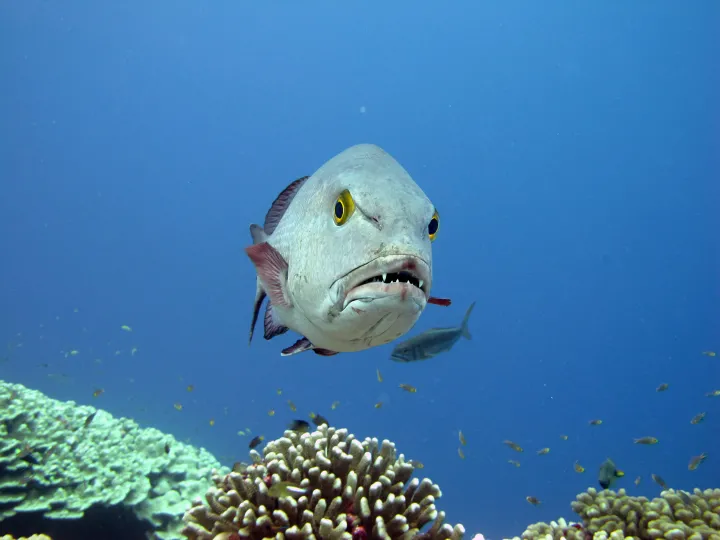Where the Shark and the Snapper Roam

The pre-industrial American landscape was once rightly described as a place where “the deer and the antelope roam.” On land, we take it for granted that the plant-eating deer and antelope far outnumber the wolves and other predators that eat them. Over the years, when scientists saw many plant-eaters and small fish on coral reefs but relatively few large predators like sharks and snappers, they assumed that the underwater landscape mirrored this familiar pattern. But as we explore reefs far from human settlements, we're finding that this assumption may be wrong: coral reefs and other coastal ocean areas may have a very different structure to them.
The science underlying this pattern has to do with how energy (food) moves from the bottom to the top of the food chain. Plants (at the bottom of the food chain) capture the energy in sunlight and use some of it to grow and reproduce. In turn, some of this new plant material is transferred to the animals that eat them, including the deer and the antelope. These plant-eaters then feed animal-eaters, such as wolves. However, when a wolf hunts, it doesn't receive all the plant energy ever eaten by its antelope prey; the antelope has already used much of that energy in its daily life of finding more food, fleeing from predators, and reproducing. Because energy is lost at each step in the food chain, less is available to the top predators. On land this translates to relatively few top predators compared to the plant eaters and smaller animal eaters that the top predators eat.
But just because a pattern is obvious on land doesn't mean it works that way underwater. While early observations on coral reefs fit with the prevailing wisdom, there was one major problem with these observations: they were made at places that were easy for humans to get to, places where people had long been fishing. As marine scientists travel farther afield, as we recently did on an expedition to the Southern Line Islands, this view of a seascape with few top predators has unraveled.
This began when two marine scientists compared the fish communities of the main Hawaiian Islands, where people live, with communities near the uninhabited northwestern Hawaiian Islands. To their surprise, they found that where there is no fishing, top predators ruled the waves; in the uninhabited areas, top predators made up more than 54 percent of total fish biomass compared to just three percent in areas near human settlement. Later, a series of expeditions to remote islands of the Pacific have confirmed that this pattern of seeing more top predators than prey can be found on other uninhabited reefs. On Kingman Atoll, for example, sharks and large snappers and jacks represent 85 percent of the total weight of fishes! Information from a variety of historical sources has confirmed that these patterns were typical of coastal ocean environments around the world before fishing removed many large predators.
So how can a coral reef have the equivalent of multiple wolves for every white-tailed deer? It turns out that some important differences between land and sea underpin this paradox. Chief among them is the difference in how quickly photosynthetic organisms like plants and algae take the energy from sunlight and turn it into food for the animals that eat them. On land, green plants are the key players; but in the ocean, photosynthesis starts with bacteria and other single-celled organisms that grow much more quickly than, say, grass. Even seaweeds, the closest equivalents to grass on the seafloor, grow more quickly than most green plants on land. This means that food is being created from sunlight more quickly in the ocean, and so more of it can be sent up the food chain.
Ocean animals also don’t have to spend as much energy fighting gravity as we do on land, and this saved energy also makes it up the food chain. Finally, most ocean animals are cold-blooded, whereas on land warm-blooded birds and mammals are dominant. Cold-blooded animals don’t burn energy to maintain their body temperature, and so more of the food they consume gets turned into food for their predators. The fact that top predators are mostly cold-blooded in the ocean also means that they can wait around for their next meal far longer than their warm-blooded equivalents on land. Taken together, these differences explain why ocean food chains are so top heavy.
In retrospect, having lots of wolf equivalents swimming around the ocean, often with empty stomachs, is not so surprising. But because ocean scientists had been studying ecosystems stripped of larger organisms by fishing for so long, and because these stripped-down ecosystems reminded them of ecosystems on land, they didn’t realize that what they were studying in the ocean was far from the natural scheme of things. Underwater it is the top predators that reign (or should reign)—although these days you have to travel to remote or well-protected places to see them in their full glory.
This post was co-authored with Nancy Knowlton, Sant Ocean Chair of the Smithsonian National Museum of Natural History and Editor-in-Chief of the Ocean Portal. Read more blog posts from their Expedition to the Southern Line Islands.


